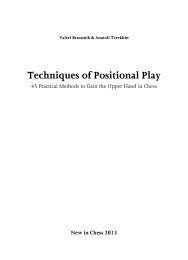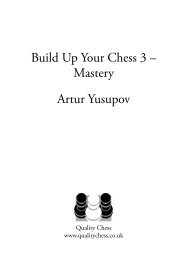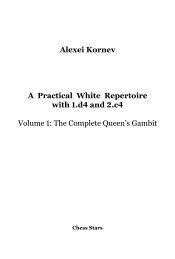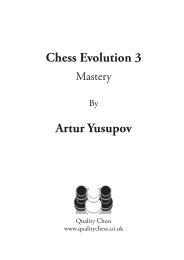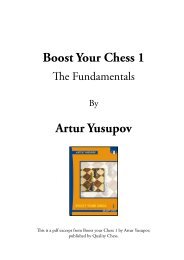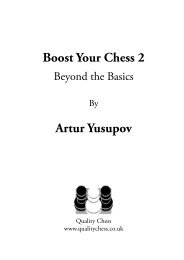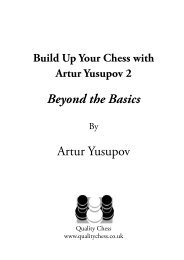The Complete Kalashnikov.indb - Chess Cafe
The Complete Kalashnikov.indb - Chess Cafe
The Complete Kalashnikov.indb - Chess Cafe
- No tags were found...
Create successful ePaper yourself
Turn your PDF publications into a flip-book with our unique Google optimized e-Paper software.
TABLE OF CONTENTSKey to symbols 5Preface 7Introduction 9Chapter 1. 6.1c3 7...e7 — Introduction / 8.e3 [B32] 11Chapter 2. 6.1c3 7...e7 — 8.d5 [B32] 23Chapter 3. 6.1c3 7...e7 — 8.c4 [B32] 29Chapter 4. 6.1c3 7...b5 — Introduction / 8...XXX [B32] 61Chapter 5. 6.1c3 7...b5 — 8...ge7 Introduction / 9.XXX [B32] 71Chapter 6. 6.1c3 7...b5 — 8...ge7 10.cxd5 [B32] 83Chapter 7. 6.1c3 7...b5 8...ge7 10.exd5 11...e7 [B32] 107Chapter 8. 6.1c3 7...b5 8...ge7 10.exd5 11...d7! [B32] 131Chapter 9. 6.1c3 7...e6 Introduction / 8.XXX [B32] 145Chapter 10. 6.1c3 7...e6 8.c4 [B32] 157Chapter 11. 6.c4 Introduction / 7.XXX [B32] 173Chapter 12. 6.c4 Introduction / 8...f5 [B32] 183Chapter 13. 6.c4 8...e6 [B32] 201Chapter 14. 5.XXX [B33] 223Chapter 15. 6.XXX [B33] 237
KEY TO SYMBOLS= Equality or equal chances White has a slight advantage Black has a slight advantage White is better Black is better+- White has a decisive advantage-+ Black has a decisive advantage unclear with compensation with counterplay with initiative with an attack with the idea only moveN novelty! a good move!! an excellent move? a weak move?? a blunder!? an interesing move?! a dubious move+ check# mate
PREFACEIt’s in 1834 that the French champion Labourdonnais played 4...e5 for the firsttime. But the <strong>Kalashnikov</strong>, that promises Black dynamic compensation inexchange for the apparent weakness of the d5 square and the backwards d6pawn, is a decidedly modern opening. That’s why the opening only startedgaining in popularity in the late 1980’s, in particular thanks to the famous Russiangrandmaster Evgeny Sveshnikov. Ever since, many top level players haveadded it to their repertoire: Pavel Tregubov, Alexei Fedorov, Etiennen Bacrot,Alexander Moiseenko and let’s not forget the most famous one amongst them,Teimour Radjabov. In France, there was a fashion effect after the fantastic victoryby Igor Nataf over John Nunn in 1999. Ever since then, we have ourselves,Matthieu and Fabien, been regularly playing it over the years and we had verycorrect results.We always thought that the <strong>Kalashnikov</strong> was not well-known enough and thatits potential was underestimated. <strong>The</strong>re are very few books about it and theyare not recent. That’s why we got the idea of writing a new book about thisopening, in order to share our passion and our ideas. When Arkadij Naiditschgave us the opportunity to do it, we didn’t hesitate. We were initially planningto only build a Black repertoire, but we quickly realized it would be a shame tonot reveal all — or let’s say most of the lines and ideas that are concealed withinthe <strong>Kalashnikov</strong>. On an unbiased basis, we present objective and exhaustiveanalyses of every line, with numerous novelties. Our goal is for our reader tobuild a complete Black repertoire and for him not to be afraid of facing the<strong>Kalashnikov</strong> with White any longer. We know what we are talking about: aswe are both 1.e4 players, we could often have been confronted to this opening,but as many others, we have often chosen to avoid it by playing 3.Nc3 or3.Bb5. Since the beginning of this project, namely in 2011, we decided to testour analyses in practice, with both colours. Cornette, M — Roy Chowdhury,S, Vandoeuvre 2011 1–0, Cornette, M — Pap, M, Metz 2012 1–0 with White, butalso, Barbosa, E — Libiszewski, F, Cannes 2011 0–1, Korneev, O — Cornette,M, Metz 2012 0–1 and more recently Korneev, O — Libiszewski, F, BagnaraCalabra 2013 0.5–0.5 with Black are a part of the results of these tests. <strong>The</strong>segames are all featured in this book.
With the translation of our book “<strong>The</strong> <strong>Complete</strong> <strong>Kalashnikov</strong>” into English,we have performed some updates to it. Following some feedback we receivedabout the first edition, we carried out some small changes, added news gamesand of course found some improvements.We hope that our analyses will offer you as much pleasure and success as theydid to us.Hope you enjoy it,GM Fabien Libiszewski and GM Matthieu Cornette,Bordeaux the 21th February 2013.Bibliography:Mega Database 2013.Corr Database 2013.<strong>The</strong> Week In <strong>Chess</strong>.
INTRODUCTION1.e4 c5 2.f3 c6 3.d4 cxd4 4.xd4e5Unlike other opening books, this onedoesn’t only address one of the colours:throughout the writing we havetried to be objective in the evaluationof the different positions arising fromthe <strong>Kalashnikov</strong>.In the labyrinth of this opening thatwas popularized by Evgeni Sveshnikov,we nevertheless had to choose apath: after pacing it to and fro, we decidedto recommend the line startingwith 5.b5 d6 6.1c3 to White. Westart our journey by analysing thisvariation and we are devoting the tenfirst chapters of the book to it, i.e. itsmajor part. After 6...a6 7.a3, Blackhas different options, two of which weconsider to be particularly interesting:— 7...e7, the most fashionablemove, is our recommendation forBlack. It’s a pretty solid continuationwhich we will analyse in the chapters1 to 3, 8.c4 being the critical line.White has the choice between 10.g3,which is the most played move, and10.d3, which has the benefit of leadingto less forced lines. For this reason,we are advising 10. d3 to White.— 7...b5 has always been the mostplayed move. After 8.d5, Blackneeds to continue by 8...ge7. <strong>The</strong>other 8th moves are analysed inchapter 4, but they give better play toWhite. After 8...ge7 9.c4 xd5, 10.exd5 is the critical move, leading tovery rich positions. <strong>The</strong> solid 10.cxd5is analysed in chapter 6, but it doesn’tpromise any advantage to White. Ifthey play 10.exd5 however, Blackneeds to react well: after the popular11... e7, we think that white can obtainan advantage after 12.d3 (seechapter 7). <strong>The</strong> line 11...d7!? (chapter8) is very rarely played, but it leadsto new positions and ideas. Accordingto us, it’s the only way to make thevariation “live”, even if everything isnot always easy for Black.A last possibility after 7.a3 is to play7...e6: we are looking at variationsresulting from this move in chap-
10 Introductionters 9 and 10.9.c4 is clearly the bestmove for White and it guaranteesthem a certain advantage.This concludes the analysis of 6.1c3and thus of the repertoire we adviseto those playing with the white pieces.We then thoroughly analyse 6.c4(chapters 11 to 13), the other move thatis often played by White; chapter 11 isdedicated to the white side lines startingfrom move seven. We have thendecided to divide the rest of this lineinto two distinct chapters: the 12thchapter is devoted to the variationsarising after 8...f5, a rather dynamiccontinuation, while the 13th chapterlooks at the more solid 8...e6.Both moves seem to be theoreticallycorrect to us, but 8... e6 is definitelymore secure. To end with, wededicate the last two chapters to rapiddeviations of White; chapter 14 is devotedto secondary 5th white moves,while chapter 15 analyses White’s 6thmoves others than 6.1c3 and 6.c4.
CHAPTER 16.1c3 7...e7Introduction / 8.e3 [B32]1.e4 c5 2.f3 c6 3.d4 cxd4 4.xd4e5 5.b5 d6 6.1c3 a6 7.a3 e7Here is the most fashionable move,that we recommend to Black. Moiseenkoplayed it in 2011, as well asof course Sveshnikov. Other grandmasterssuch as Radjabov, Ikonnikovor Federov, who are also specialistsof this opening, have also played itrecently. <strong>The</strong> idea is playing f6without White having the moveg5. White has the choice betweenthree moves here: 8. d5, as it is oftentempting to occupy this square(chapter 2), 8.c4, the most playedmove, the idea of which is to makeuse of the fact that Black hasn’t playedb5 yet (chapter 3) and finally 8.e3,with the idea of playing on the b6square after d5 or c4 to follow.This is the rarest one out of the threemoves, but it has recently been playedseveral times by very good players.8...f6!?<strong>The</strong> move we recommend.8...b5 has been tried by Moiseenkoand Fedorov in 2011. This move isprobably playable, but we don’t reallylike the type of position with a closedcenter that arises from it. 9.d5 b810.c4 b4 11.c2 f6(11...a5 is too slow. 12.d3 f613.e2 is the most precise.(13. d1 0–0 (13...b3 14.xf6+xf6 15.axb3 0–0 16.e2 A. Zhigalko–A.Fedorov / Minsk 2011.)14.e2 a4 With an unclear position.)13...0–0 14.0–0 Followed by d1.)12.d3a) 12.d3 A rather strange move, aswe think it is logical to play on thed-file. 12...d7 13.0–0 c5 14.a3 a515.axb4 axb4= D. Guerra Bastida–S.Maze / Linares 2005;8.e3b) 12.f3 b3!? Black is trying to getcounterplay right away.
12 Chapter 113.axb3 xb3 14.cb4(14.b1 0–0b1) 14...a5 15.a2 b8 16.e20–0 17.a3 xd5 18.cxd5 b419.xb4 axb4 20.a5!;b2) 14...xd5 15.cxd5 b4 16.d2xc2+ (16...d3+ 17.xd3 xd318.a5 d7 19.0–0 0–0 20.b4e3 21.c6) 17.xc2 b818.xa6;15.a2 b8 16.e2 h5 Followedby g5. <strong>The</strong> position is uncertain.)14... xd5 15. xd5 (15. xc6? xe3+) 15...xb2 16.a4 d717.a3 b8!?N (17...b8 B. Vuckovic–M.Pap / Belgrade 2007.)18.c7+ f8 19.b5! h4+ 20.d1b4 With a complicated positionwhere Black doesn’t have any troublewith finding counterplay.;12...0–0 13.e2 d7!?N A good improvement.Black wants to play g5and the knight will possibly go to c5.(13...g4?! We don’t like thismove very much. In the gameBlack found an interesting idea,but unfortunately it doesn’t work:14.d2 g5 15.d1 xf2? A toobold sacrifice. (15...xd2+ is themost natural continuation, butit leaves White with a small advantage.16.xd2 h4 17.g3xg3 18.hxg3 b3 19.axb3 xb320.f3 h6 21.ce3) 16.xf2 f517.g1 fxe4 18.xe4 b3 (18...xd219.xd2 a5 20.d3!) 19.axb3 xb3 20.g4 xd2 21.xc8h6 22.e6+ h8 23.h4 V. Iordachescu–A.Moiseenko / Aix-les-Bains FRA 2011.)14.d1
<strong>The</strong> <strong>Complete</strong> <strong>Kalashnikov</strong> 13(14. xe7+ xe7 15.d1 f6!16.g5a) 16.0–0 d8;b) 16.xd6 b7! An importantmove as Black will be ableto develop rapidly while puttingpressure on the e4 pawn, whileWhite’s pieces are not very wellcoordinated. <strong>The</strong> e3 is for exampletaking away the knight’ssquare.If White plays 17.xd6 then Blackwill find good counterplay after 17...b7 18.d3 defending the e4 pawnand after 18...fd8 19.d5 xg2Black has won the pawn back.;8...b8 has already been played bygrandmasters Fedorov and Mazé.9.d5 b5 transposes to 8...b5 9.d5b8.17.d3 e6 18.g5 (18.0–0 fd819.b3 xe4=) 18...fd8 19.f3 xd1+ 20. xd1 b3 21.axb3xb3;16...d8 17.f3 h6 18.xf6 xf619.xf6 gxf6 20.b3 f5 Blackdoesn’t have any problems here, asthe bad white bishop compensatesfor their inferior structure.)14...g5 15.xg5 xg5 16.de3f6 With a complicated position.Black managed to exchange theirblack squared bishop and he willsimply play d8 on te next move.9.c49.d5 doesn’t give much to White.9...xd5 10.exd5 d4! A thematicpawn sacrifice. (10...b8 11.c4d7 12.a4 D. Le Goff–H. Tirard /Fouesnant 2007.)
14 Chapter 19...e6 This move seems to be playable,but Black will have to play veryprecisely.11.d3 (11.c3 f5 12.d2 g5Black doesn’t have any problem atall. M. Bezgodova–P. Nakhapetiane/ Izhevsk RUS 2011.; 11.xd4 is toorisky. This is a recurrent theme in the<strong>Kalashnikov</strong>: if White takes the pawnfor the price of his black squaredbishop, then the opening of the filesfavors Black. 11...exd4 12.xd4 0–0Black got an overwhelming initiativein A. Kovchan–P. Eljanov / Dnipropetrovsk2000. f6 and e8 will follow.)11...f5(11...0–0 12.0–0 (12.c4?! b5 13.d2f5 14.xf5 xf5 15.0–0 c7 J.Polgar–T. Radjabov / Rishon Le Ziyyon2006.) 12...f5 See 11...f5.)12.d2 0–0 13.c4 Threateninga5. 13...a5 (13...b8!? 14.0–0 c715.b3 c5 is also a possibility, withan interesting position.) 14.a4 b615.0–0 a6 16.g4 h4 17.e2 xc4 18.xc4 g5 19.e1 f5B. Socko–T. Radjabov / Novi Sad2009.9...b5!?This is the best way to go on in ouropinion.10.d5 (10.b6 b8 11.e2 0–012.0–0 xe4!? leads to simplifications.13.xe4 d5 14.c5 d4 15.xe6fxe6 16.c4 dxe3 17.xe3 c5= Despitehis bad structure, Black equalizedin C. Balogh–K. Kerek / Hungary2001. <strong>The</strong> c5 is on the rightdiagonal, where he puts pressure onthe f2 pawn, while White has somedifficulties to coordinate his pieces.)10...0–0! We think that this is theright continuation:a) 10...b5?! 11.xf6+! gxf6 A sad necessity.12.b6 b8 13.d5 f5 14.exf5xf5 15.d3 It is clear that Whiteis better here: A. Vovk–V. Ikonnikov/ Vlissingen 2009.;b) 10...xd5 11.exd5 a7 (11...d412.xd4 exd4 13.xd4 b5 14.e3And Black didn’t have enough compensationin the following game:D. Kryakvin–V. Laznicka / Pardubice2007.; 11...b5N We think thatthis move which is suggested by thecomputer is dubious: 12.b6 b813.dxc6 xb6 14.xb6 xb6 15.a4)12.a4! <strong>The</strong> most precise.
<strong>The</strong> <strong>Complete</strong> <strong>Kalashnikov</strong> 15(12.b6 b8 13.c4 (13.a4 0–014.e2 c8 15.a5 xb6 16.xb6e8 17.0–0 d7 18.e3 f5 Withan unclear position in the gameJ. Echavarria–A. Zapata / Cali2003.) 13...0–0 14.d3 c8!=D. Naroditsky–R. Hess / BerkeleyUSA 2011.)12...c8 13.e2 0–0 14.0–0 <strong>The</strong>position is certainly complicated,but we think White is better. He cangain some space on the queenside byplaying b4 and / or a5, but he canalso play on the kingside by f4, whileBlack is lacking some perspective.;11. xe7+ This move obviouslyneeds to be looked at! White willtake the d6 pawn.a) 11.b6 c8!?N <strong>The</strong> advantagecompared to 11...d7 is that Whitecannot take back with the queenanymore. (11...d7 was played inI. Smirin–U. Boensch / Fuegen2006. 12.xf6+N xf6 13.xd6c8 14.0–0–0) 12.xd6a1) 12.xf6+ xf6 13.xd6?! (13.xd6 transposes to 12.xd6.) 13...d4 14.xd4 d8 15.c5 exd4;a2) 12.xe7+? is bad since after12...xe7 White can’t take on d6and Black will thus continue by thethematic d5. 13.xd6? c6–+ Followedby d8.;12...d7! 13.xf6+ xf6 14.c4d4 With good compensation forthe pawn.;b) 11.xf6+ xf6! 12.xd6 Blackhas two different ways of going onhere, but both promise them goodcompensation: (12.xd6?! d4!Black has the initiative.) 12...b5(12...e8!? also seems possible inorder to keep the queens on theboard. <strong>The</strong> idea is to play e7 ord8 and of course b5. 13.b6 (13.b6 d8! A very strong move!Black has the initiative.) 13...e714.d2 d8 15.d5 f5! 16.d3 (16.xe7+ xe7 17.c3 fxe4 Witha complicated position.) 16...fxe417. xe4 b4 18. xe7+ xe719.e2 h4 20.c5 f4 21.d3xd3+ 22.cxd3 f5 <strong>The</strong> oppositecolored bishops give Black good attackingchances.)13.xc6(13.xd8 axd8 14.a3 (14.d2b4!= Black will win one pawnback.; 14.b6 b4=) 14...e7 15.c3xa3 16.bxa3 a8!? Preventing a4.17.e2 fc8 Followed by a5. <strong>The</strong>position is equal.)
16 Chapter 113...bxc4 14.e2 (14.c5 e7!?15.xe5 f6 16.g3 xb2 17.d1c3+ 18.d2 xd2+ 19.xd2 a5Black has the initiative.; 14.b4 A realcomputer move. 14...b8) 14...g5!(14...b8 15.b3 (15.0–0 xb216.xc4 xc4 17.xc4 c8!=Black will win the c2 pawn back.;15.xa6 g5! With good compensation.)15...a5+ 16. d2a3 With the idea of playingfc8. 17.xc4 b2 18.0–0 fc819.xa6 a8 20.b5 ab8 (20...xc4 21.bxc4 xc2 22.e3 ab823.ac1 xe4 24.b6) 21.a4xc4 22.bxc4 d4 23.e3 xe424. fb1)15.b6b1) 15.0–0?! xe3 16.fxe3 d2;b2) 15.xg5?! xg5 16.0–0 (16.f3ab8) 16...d2!;18...c3! (18...xc2 19.f4! f6 20.d1!xe2! A good exchange sacrifice.21.xe2 h6 22.f5 xf5 23.exf5 fxe524.g4 c3 Black has good compensationin this ending.) 19. d3 (19.f4f6 20.xf6 gxf6=) 19...c8 Witha complicated position where Blackis not worse.;c) 11.e2?! xe4;11...xe7! <strong>The</strong> good way of takingback the knight.(11...xe7 12.xd6 xd6 (12...xc4 13.xe7 xe7 14.xc4xe4 15.0–0–0 <strong>The</strong> bishop pairpromises White a certain advantage.)13. xd6 b4 14.0–0–0!xa2+ 15.b1 fd8 16.e2!N Agood improvement that confrontsBlack to some problems and refutesthe 11...xe7 line. (16.c4xd6! 17.xd6 xc4 18.hd1 f819.f3 e8= A. Smith–E. Sveshnikov/ Marianske Lazne 2008.)15...xb6 16.xb6 ab8 17.c7xb2 18.xe5 Here both lines seemplayable for Black.
<strong>The</strong> <strong>Complete</strong> <strong>Kalashnikov</strong> 1716...d7 (16...b4 17.c3 c618.xb7) 17.c3)16...ed5 17.d2 b5 18.he1 f419. xf4 exf4 20.e2 f8 21.f3 xd1+ 22.xd1 e8 23.d6 e624.d8+ e7 25.a8 e4=;9...0–0 allows White to play b6,when Black will have to play d7.We would like to avoid having toplace our queen in front of the c8.12.xd6 White needs to accept thechallenge. 12...xc4!N A strongnovelty.(12...c8 13.xd8 fxd8 14.b6d7 (14...f8 15. xe5 xe416.d3 c5 17.xc5 xc5 18.f3)15.xe5 d6 16.e3 xe4 (16... xc2?! 17.d3 D. Kryakvin–M. Novik / Sochi 2008.) 17. d3c5 18.xc5 xc5 19.f3 It willbe hard for White to win this positionas the black pieces are veryactive, but obviously he is the onlyone who can play for the win here.)13.xd8 fxd8 14. xc4 xe415. d3 f6 16.0–0–0 This is thecritical position of this variation...White must be a little bit betterthanks to the bishop pair, but wethink that Black can defend this position,for example:10.b6 d7 11.e2 b8 12.0–0!(12.d2 <strong>The</strong> idea of quickly puttingpressure onto the d6 pawn doesn’tlead to anything. 12...d8 13.d1xb6 14.xb6 d8 15.xc8(15.bd5 xd5 16.xd5 h4!?(16...e6 was played in the gameO. Renet–P. Potapov / Pardubice2006.) 17. d3 g4 18.c1 e6Black doesn’t have any problem.)15...xc8 16.xd6 b6 <strong>The</strong> beginningof a nice tactical phase. (16...a5 also gives Black decent compensation.)17.a3 d4 18.d3g4! 19.0–0 h6(19...xh2!! would have won in avery nice way.
18 Chapter 120.xh2 h6+ 21.g3 (21.g1 f3+! 22.gxf3 g5+ 23.h2c6–+) 21...f4+ 22.h3 c6–+White can’t avoid getting mated.)12...d8 Once again, this is a thematicmove in this kind of situations.Black wants to chase the b6bishop in order to liberate his position.13.e3 c7 14.b6 d8 (14...xb6 15.xb6 e7 16.d3 <strong>The</strong>white position is more pleasant toplay.) 15.bd5 White has obtaineda small advantage, but he wasn’t ableto convert it in the following game:I. Saric–P. Potapov / Aix-les-BainsFRA 2011.20.h3 f3+! 21.h1 (21.gxf3??xh3 22.fxg4 xg4+ 23.h1 c6–+ With mate to follow.) 21...g5!22.f3! xh3 23.fxg4 f2+ 24.g1xg4 25.f5?? A huge defensivemistake.(25. f2! was the only move! 25...h2+ 26.f1 xf2 (26...e3+27.e2 xg2 28.d5 h5+29.d2 g5+ 30.e2=) 27.xf2f4+ 28.g1 e3)25...h2+ 26.f1 h1+ 27.e2xg2+ 28.e1 g3+ 29.e2g6–+ T. Kiroski–P. Eljanov / Ohrid2001.)10.b6 b8 11.xc811.bd5 This move doesn’t give anythingto White. 11...g4!? (11...0–0<strong>The</strong> easiest move also seems to becompletely playable. 12.e2 xd513.xd5 g5 14.0–0 xe3 15.xe3And a draw was agreed in A. Sokolov–A. Moroz / Cappelle la Grande 2007.We think the position is equal after15...e6 16.d2 c7 17.c3 fd8=)
<strong>The</strong> <strong>Complete</strong> <strong>Kalashnikov</strong> 1912.e2This move has the drawback of leavingthe e4 pawn vulnerable.12.d3 has the drawback of allowingthe e7 to move as the d1 isnot attacking the d6 pawn any longer.12.d2?!(12. xe7 xe7 (12... xe3!?13.xc6 xd1 14.xd8 xc315.xf7 xf7 16.bxc3 d7 17.d2Despite White being a pawn up,this game should end in a draw.)13. g5 h6 14.xe7 xe7 15.d5d8= Followed by e6 and f6.)12...b4 13.a4 f6 14.xe7 xe7<strong>The</strong> position is unclear, but we arestarting to like Black better as the a4knight is out of play and d6-d5 willfollow. D. Kryakvin –D. Lintchevski/ Krasnoyarsk 2007.11...xc8<strong>The</strong> critical position. White has thechoice of where to develop his f1 tonow.12...0–0(12...b4 13.0–0 xd3 14.xd3 h615.b4!? A good way to gain somespace on the queenside. (15.a3 0–016.f3 c4 17.fd1 fc8= A. Volokitin–R.Kempinski / Warsaw POL2011.) 15...0–0 16.a4 White has theinitiative.)13.0–0 d8! An important move.Black will try to exchange their darksquared bishop by playing b6.This is possible as the d6 pawn is nothanging anymore.
20 Chapter 114.a4 (14.g5?! doesn’t make muchsense as Black has 14...d7! andhe is obviously happy to exchangethe bishops. 15.e3 b6 16.g5 h617.d2 f6= Van S. Eijk–Ikonnikov/ Barcelona 2009.) 14...b4 15.d5(15.e2!?N seems to be an interestingtry to improve White’s play.<strong>The</strong> idea is to bring the knight tof5 via g3.15...b6 16.g3 (16.g5 h5Followed by c5 and h6.) 16...a517.f5 e6 18.b5(18.b3 d5! A logical move in orderto get rid of the d6 weakness.19.exd5 xd5 20.c4 (20.g4g6 21.h6+ g7 22.xe6 fxe623.g5 d4=) 20...xf5 21.xd5d4 22.d3 e6 23.xe6xe6= <strong>The</strong> position is equal.)18...e7 19.c4!? (19.xd6 xf520.xe6 fxe6 21.exf5 exf5=) 19...xc4 20.xe7+ h8 21.xd6xe4 22.xe5 xe3 23.fxe3 be8!A good move that allows Black toget sufficient compensation.24.ac1 (24.d5 c7 25.f5 e526.d3 g6 27.d4 f5) 24...f625.d5 c7 26.c6 f5 27.d4 g6And Black has enough compensationfor the pawn thanks to thestrong e4 knight and the weaknessof the e3 pawn.)15...xd5 16.exd5 e7 17.a5 (17.e2a5 doesn’t give anything to Whiteeither.) 17...xd5 18.xh7+ xh719.xd5 c7 20.c4 (20.fc1 b7!=)20...bxc3 21.bxc3= J. Smeets–V. Ikonnikov/ Germany 2009;12.a4 b4!N is a novelty that leadsto an unexpected simplification.(12...b4 <strong>The</strong> most played move.13.d5 0–0 14. xe7+ xe715.xd6 g6?! V. Iordachescu–S. Roy Chowdhury / Dubai UAE2012. (15...c6!N 16.f3 d8 17.c5)16.0–0–0!)
<strong>The</strong> <strong>Complete</strong> <strong>Kalashnikov</strong> 2113.e2a) 13. c1 0–0 14.axb5 axb5 Black’sposition is good, he will try to playd5.;b) 13.axb5?! xe4! 14. xe4 (14.a3 d5!) 14...xc2+ 15.d2 xa116.xa1 axb5 White is clearly indanger here.;13...xc2+! 14.xc2 b4 15.0–0 bxc316.bxc3 0–0 17.d3 c6 <strong>The</strong> positionis balanced. Black will playfc8 followed by the thematic d8.15. f3 f6 16.d3 xd5 17.xd5h8 Followed by f5. <strong>The</strong>re is no reasonfor Black to have any problemshere.;15.c4 f6 And now it is difficultfor White to find an useful move.15...d8 16.d316.b3 a5 17.axb4 axb4 18.c4 h816...f6=12...0–0 13.0–0 b413...d8!? was a novelty when thefirst edition of this book came out,but it has been played since. <strong>The</strong> ideais to quickly play d5.White has certain compensationsfor the pawn here, but not enoughto claim an advantage. In the game:S. Sulskis–T. Radjabov / Tallinn 2004,Black managed to win.14.a3 In order to avoid b4. (14.f3a5 Followed by c4.) 14...d5!N(14...h6 15.d3 B. Smith–V. Shishkin/ Baia Sprie ROU 2012.) 15.xd5 (15.exd5 b4! 16.axb4 xb4= Black will getthe pawn back.) 15...xe4 16.g4 f517.f3! d6 18.h3 e4 With a veryunclear position. <strong>The</strong> black queen willget back into the game via e6.Conclusion:We don’t think the recent 8.e3line is the most critical one. We recommendBlack to play 9...b5!? ratherthan having a passive position after9...0–0 or 9...e6.14.d5 xe4 15.a3!?
ArkadijNaiditschGMI ELO 2702Weekly NewsletterCsabaBaloghGMI ELO 2665Subscribe in 4 different languagesfor only 38 euro per year!!!English, French, Spanish & German.<strong>The</strong> weekly newsletteris published every Friday evening.Newsletter is sent by emailin PGN and PDF formats.Content of CEWN:» Analysis of the 4 most exciting games of the past week.» “Clash of the Titans” — one game from a World Champion, which You can’tfind in most of the books.» Between 2-5 endgame lectures.» Around 10 puzzles with solutions given in the next weekly newsletter.» Editorial preface written by Arkadij Naiditsch and Csaba Balogh on the mostexciting moments of the past week.» “Surprise” section which will be different every week. It can be an interview,some funny article or theoretical advice e.t.c.» All in all, around 30 pages of great chess material every week.Price of the subscriptions:» 38 euro per year» 10 euro per month» 4 euro per weekwww.chess-newsletter.comchessnewsletter@yahoo.com



